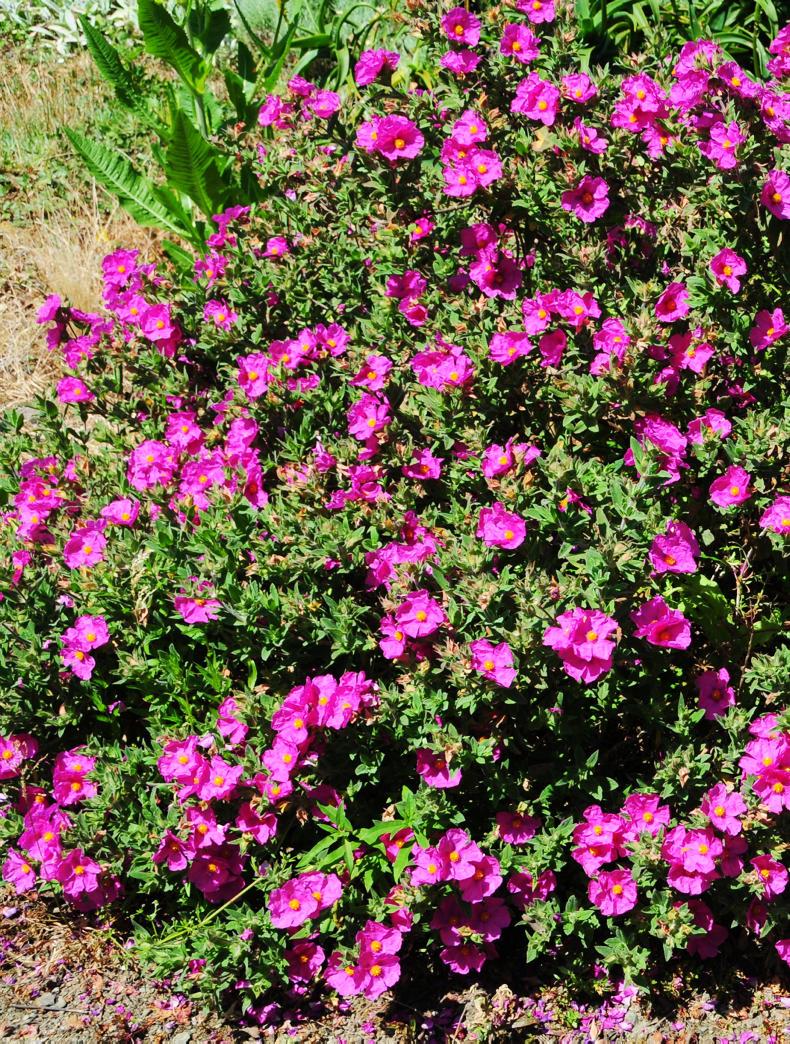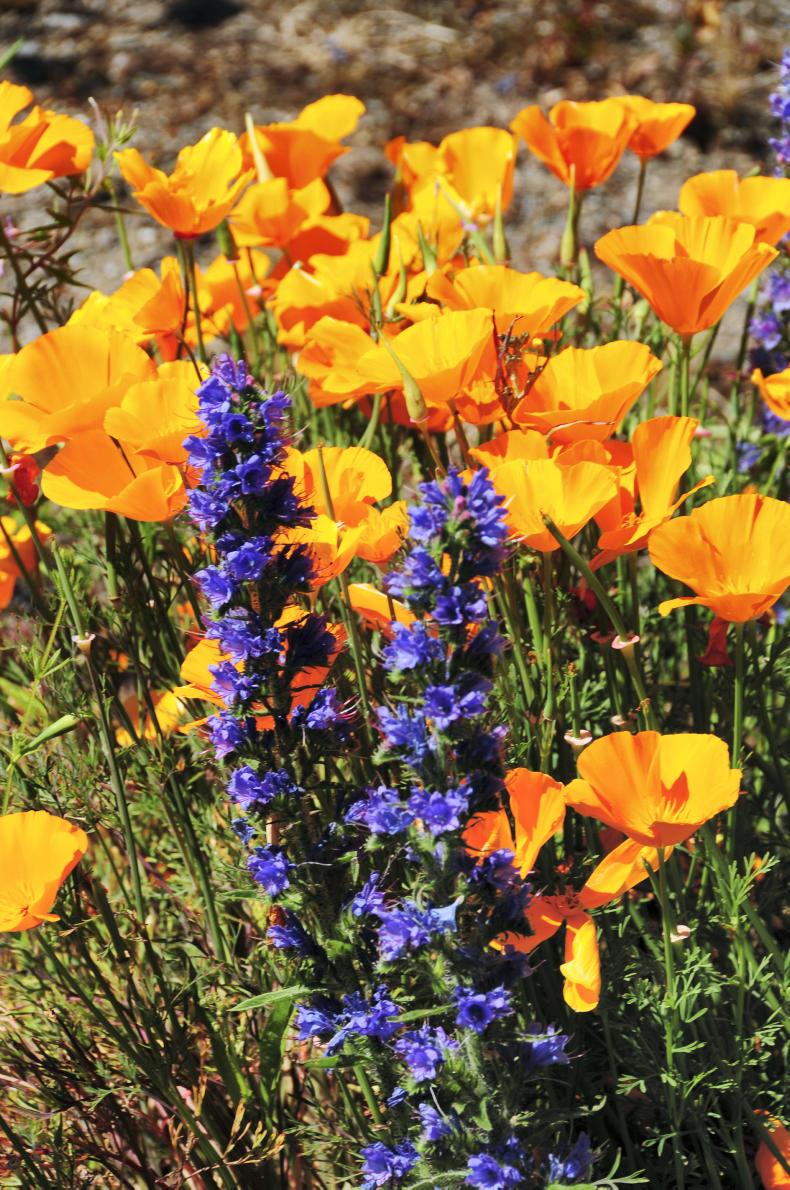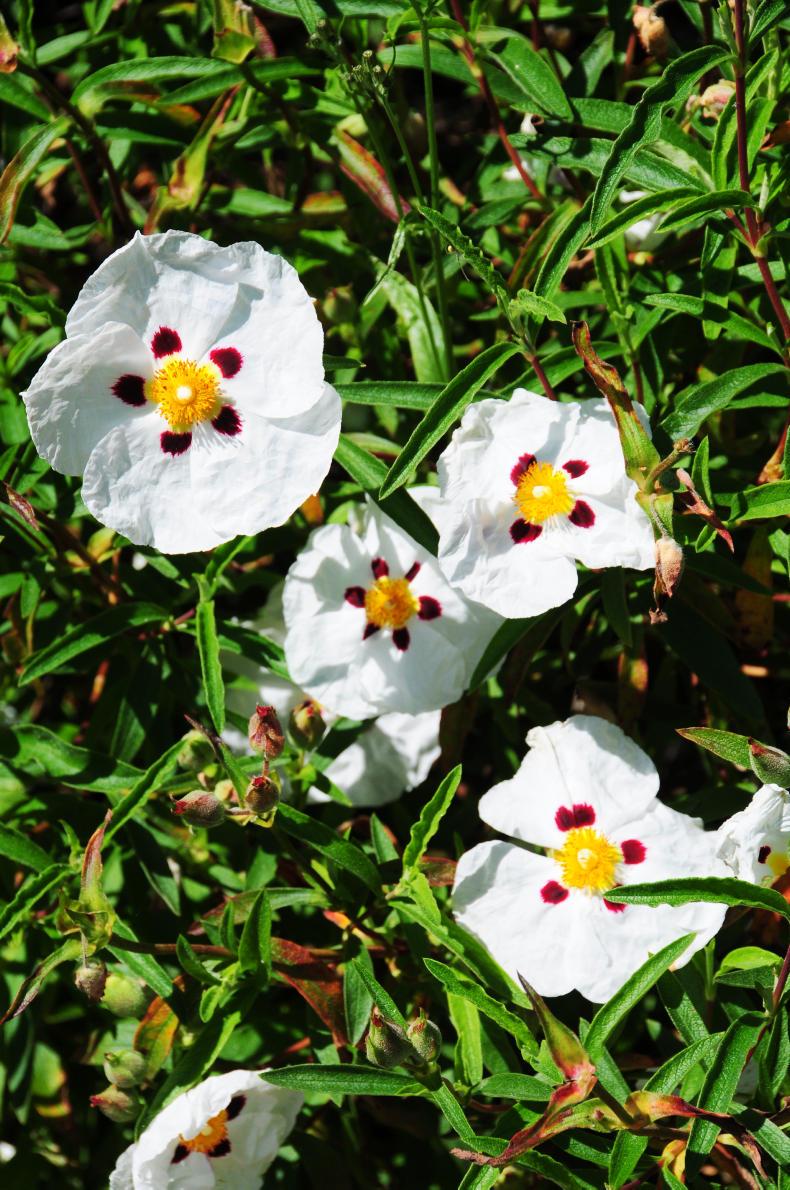Sun rose is a common name given to cistus, which is the correct botanical name and the one usually used. But sun rose is a good name because it is descriptive. The flower looks like a flat, single rose and it is indeed a sun-lover. The various species are native to the Mediterranean region, stretching from Spain to Greece. It does a lot of its growing during the mild winter and spring period in those areas and flowers later here in our cooler conditions. The cistus is not very hardy but it is not as tender as some Mediterranean plants, because it grows high up on hills.
Whole hillsides may be covered with cistus bushes, a remarkable sight in flower, just like heather on Irish hillsides in summer. The secret from those sun-baked hills is the extremely good drainage. It is quite hardy as long as it is grown on dry well-drained ground. On heavy ground, it succumbs fairly easily because the plant does not get a good chance to toughen up and fully ripen its stems to avoid freezing.
Given this background, obviously cistus is an ideal plant for a dry sunny bank. It loves sunshine and dry soil, the conditions which prevent it from growing too rapidly. Although rapid growth can be an advantage if you are trying to cover an earth bank, when it grows very rapidly in a windy area, it is inclined to split apart in strong winds. However, it normally resists wind very well, being native to very exposed hillsides. Most kinds have small, hairy or sticky leaves, all well adapted to preventing moisture loss and wind damage. Some kinds are tall, but others are as low as heather bushes and are often seen not far from heather bushes on Mediterranean hillsides.

Cistus purpureus.
There are several lovely garden kinds and they are widely available, even if not very widely grown. The two most commonly available are Cistus corbariensis, which has large white flowers, and Cistus purpureus, with large purple flowers with darker blotches. Cistus pulverulentus has vivid magenta-pink flowers. Pale pink-flowered with greyish leaves is Cistus skanbergii. One of the most beautiful of the lot is Cistus ladanifer, with large, purple-blotched white flowers. This species also produces a scented resin, called ladanum, on the leaves and young stems. On a warm day, this makes a very pleasant scented atmosphere in the garden. This resin-scented substance is used as part of the base of perfumes.
Apart from species and hybrids, there are named varieties, such as the small and neat ‘Grayswood Pink’, masses of soft pink flowers against grey-green foliage; ‘Silver Pink’ with bright pink flowers, ‘Peggy Sammons’ with purple-pink flowers; ‘Sunset’ is a neat compact form of Cistus pulverulentus with grey-green leaves, a widely available and reliable plant. This and ‘Silver Pink’ would be two relatively hardy varieties for areas where the challenge of frost might be greater, but the key to success, even with these hardier kinds, is very free-draining soil in sunlight. The flowers of all of these kinds do not last long but they are produced in large numbers over a period of many weeks.
All of the sun roses have evergreen foliage, in common with many Mediterranean plants because it gives them a quick start in spring to grow and flower before the baking heat of summer. The foliage stands up well to all but the hardest frost. In cold weather, the leaves droop from the branches but the heavy grey-green colour of the leaves adds interest to the winter garden. In fact, cistus are far more likely to lose their evergreen foliage in summer because of drought, although this is hardly likely to happen in our cool summer climate!

California poppy.
The California poppy is not a true poppy like the red poppies of Irish roadsides but it is a member of the larger poppy family and the flowers are very poppy-like. The flowers are flat, open and shiny on the surface, in shades of orange and yellow, although red and pink tones have been added by the plant breeders in recent years. The colours are rivetting, brilliant, joyous and blaring of the hot sunshine of the part of the world from which they came. The plants are very easy to grow from seeds.
Fruit, vegetables and herbs
Plant out tender vegetables such as sweet corn and runner beans during suitable weather if not already done. Spray apple trees for apple scab disease and check for greenflies at the same time. Repeat sowings of vegetables sown early, such as lettuce and peas, could be made. Thin out vegetables that have reached suitable size, and control weeds early.
Lawn
The near-drought conditions affected grass growth significantly and many lawns were showing signs of drought with scorched grass in patches. Variable amounts of rainfall have affected growth in different ways depending on how much fell, but not enough for good grass growth in most places. Cut the edges around flower beds or borders, before the grass gets long.
Trees, shrubs and roses
Continue to prune spring shrubs and early summer shrubs as they go out of flower, if necessary. Continue to tie in the new shoots of climbing roses so that they will be in the correct position for training later. Continue to spray roses against blackspot disease, especially in the damper parts of the country and after wet weather.
Flowers
Hanging baskets and other containers should be planted up by now and bedding plants should be planted out. Watch out for slugs and snails in the first few weeks after planting as they can wipe out new bedding plants in a single night. Dahlias and corms of gladiolus can be planted out where they are to flower.
Greenhouse and house plants
Plant out tomatoes, chilli peppers, cucumbers and sweet pepper plants. Feed greenhouse plants strongly now to get good growth before mid-summer and water well. Spray a grapevine if it had mildew disease last year. Houseplants can be re-potted now.
Read more
In the garden with Gerry Daly: making plans
In the garden with Gerry Daly: planting hedges
Sun rose is a common name given to cistus, which is the correct botanical name and the one usually used. But sun rose is a good name because it is descriptive. The flower looks like a flat, single rose and it is indeed a sun-lover. The various species are native to the Mediterranean region, stretching from Spain to Greece. It does a lot of its growing during the mild winter and spring period in those areas and flowers later here in our cooler conditions. The cistus is not very hardy but it is not as tender as some Mediterranean plants, because it grows high up on hills.
Whole hillsides may be covered with cistus bushes, a remarkable sight in flower, just like heather on Irish hillsides in summer. The secret from those sun-baked hills is the extremely good drainage. It is quite hardy as long as it is grown on dry well-drained ground. On heavy ground, it succumbs fairly easily because the plant does not get a good chance to toughen up and fully ripen its stems to avoid freezing.
Given this background, obviously cistus is an ideal plant for a dry sunny bank. It loves sunshine and dry soil, the conditions which prevent it from growing too rapidly. Although rapid growth can be an advantage if you are trying to cover an earth bank, when it grows very rapidly in a windy area, it is inclined to split apart in strong winds. However, it normally resists wind very well, being native to very exposed hillsides. Most kinds have small, hairy or sticky leaves, all well adapted to preventing moisture loss and wind damage. Some kinds are tall, but others are as low as heather bushes and are often seen not far from heather bushes on Mediterranean hillsides.

Cistus purpureus.
There are several lovely garden kinds and they are widely available, even if not very widely grown. The two most commonly available are Cistus corbariensis, which has large white flowers, and Cistus purpureus, with large purple flowers with darker blotches. Cistus pulverulentus has vivid magenta-pink flowers. Pale pink-flowered with greyish leaves is Cistus skanbergii. One of the most beautiful of the lot is Cistus ladanifer, with large, purple-blotched white flowers. This species also produces a scented resin, called ladanum, on the leaves and young stems. On a warm day, this makes a very pleasant scented atmosphere in the garden. This resin-scented substance is used as part of the base of perfumes.
Apart from species and hybrids, there are named varieties, such as the small and neat ‘Grayswood Pink’, masses of soft pink flowers against grey-green foliage; ‘Silver Pink’ with bright pink flowers, ‘Peggy Sammons’ with purple-pink flowers; ‘Sunset’ is a neat compact form of Cistus pulverulentus with grey-green leaves, a widely available and reliable plant. This and ‘Silver Pink’ would be two relatively hardy varieties for areas where the challenge of frost might be greater, but the key to success, even with these hardier kinds, is very free-draining soil in sunlight. The flowers of all of these kinds do not last long but they are produced in large numbers over a period of many weeks.
All of the sun roses have evergreen foliage, in common with many Mediterranean plants because it gives them a quick start in spring to grow and flower before the baking heat of summer. The foliage stands up well to all but the hardest frost. In cold weather, the leaves droop from the branches but the heavy grey-green colour of the leaves adds interest to the winter garden. In fact, cistus are far more likely to lose their evergreen foliage in summer because of drought, although this is hardly likely to happen in our cool summer climate!

California poppy.
The California poppy is not a true poppy like the red poppies of Irish roadsides but it is a member of the larger poppy family and the flowers are very poppy-like. The flowers are flat, open and shiny on the surface, in shades of orange and yellow, although red and pink tones have been added by the plant breeders in recent years. The colours are rivetting, brilliant, joyous and blaring of the hot sunshine of the part of the world from which they came. The plants are very easy to grow from seeds.
Fruit, vegetables and herbs
Plant out tender vegetables such as sweet corn and runner beans during suitable weather if not already done. Spray apple trees for apple scab disease and check for greenflies at the same time. Repeat sowings of vegetables sown early, such as lettuce and peas, could be made. Thin out vegetables that have reached suitable size, and control weeds early.
Lawn
The near-drought conditions affected grass growth significantly and many lawns were showing signs of drought with scorched grass in patches. Variable amounts of rainfall have affected growth in different ways depending on how much fell, but not enough for good grass growth in most places. Cut the edges around flower beds or borders, before the grass gets long.
Trees, shrubs and roses
Continue to prune spring shrubs and early summer shrubs as they go out of flower, if necessary. Continue to tie in the new shoots of climbing roses so that they will be in the correct position for training later. Continue to spray roses against blackspot disease, especially in the damper parts of the country and after wet weather.
Flowers
Hanging baskets and other containers should be planted up by now and bedding plants should be planted out. Watch out for slugs and snails in the first few weeks after planting as they can wipe out new bedding plants in a single night. Dahlias and corms of gladiolus can be planted out where they are to flower.
Greenhouse and house plants
Plant out tomatoes, chilli peppers, cucumbers and sweet pepper plants. Feed greenhouse plants strongly now to get good growth before mid-summer and water well. Spray a grapevine if it had mildew disease last year. Houseplants can be re-potted now.
Read more
In the garden with Gerry Daly: making plans
In the garden with Gerry Daly: planting hedges








 This is a subscriber-only article
This is a subscriber-only article









SHARING OPTIONS: